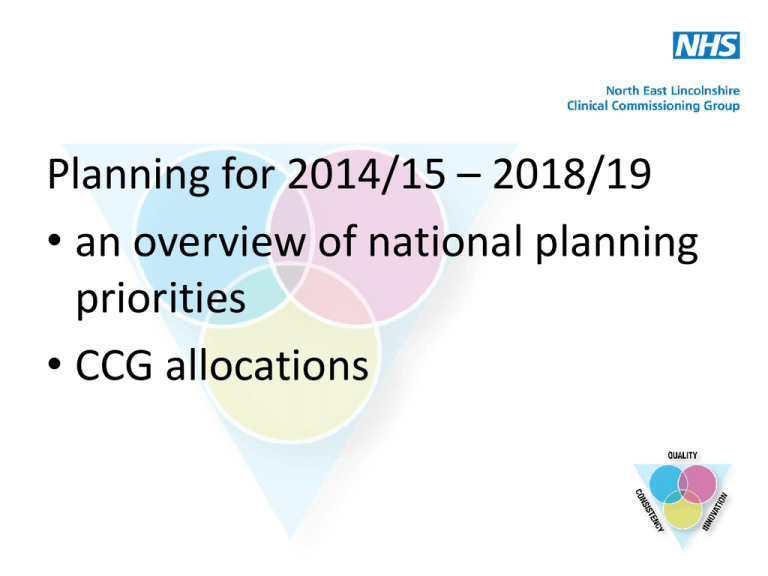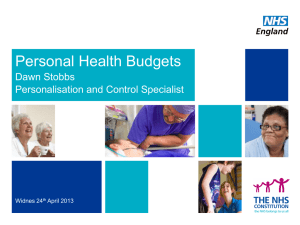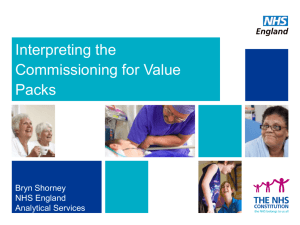item-06-national-nhs-planning-guidance
advertisement

Planning for 2014/15 – 2018/19 • an overview of national planning priorities • CCG allocations Planning Framework NHS | Presentation to [XXXX Company] | [Type Date] 2 Planning Framework • • • • • 1 Vision 5 Outcome Domains 7 Outcome Measures 3 Key Measures 6 Characteristics of High Quality, Sustainable Health and Care Systems • 4 Essential Elements NHS | Presentation to [XXXX Company] | [Type Date] 3 Vision High quality care for all, now and for future generations • • • • Driven by quality in all we do Equal access for all, especially the vulnerable and excluded Spread existing excellence Sustainable, high quality for the long term 5 Outcome Domains and 7 Measures (Ambitions) Domain Outcomes Measures 1) Preventing Premature Death 1) Securing additional years of life for people with treatable mental and physical conditions 2) Quality of Life for Long Term Conditions 2) Improving health related quality of life for people with long term conditions 3) Quick Recovery from Ill Health 3) Reducing avoidable time in hospital 4) Increasing elderly people living independently at home on discharge 4) Great Experience of Care 5) Increasing positive experience of hospital care 6) Increasing positive experience of care outside hospital 5) Safe Care 7) Significant progress on eliminating avoidable deaths 3 Key Measures Key Measures 1) Improving Health Promoting health, preventing ill health in partnership 2) Reducing Health Inequalities Better care for the most vulnerable 3) Parity of Esteem For mental and physical health 6 System Characteristics The 6 characteristics of high quality, sustainable health and care systems in 5 years time are: • Citizen inclusion and empowerment • Wider primary care, provided at scale • A modern model of integrated care • Access to the highest quality urgent and emergency care • A step-change in the productivity of elective care • Specialised services concentrated in centres of excellence 7 NHS | Presentation to [XXXX Company] | [Type Date] 1.Citizen Inclusion & Empowerment • • • 8 Listening to patients’ views – Patients to participate in planning, managing and deciding about their care – Patient participation in the commissioning process – “Transforming Participation in Health & Care” guidance, Friends & family test expansion, Personal Health Budgets Better care through the digital revolution – Increased patient access to healthcare records – Telehealth and telecare Transparency and sharing data – Publishing outcomes data – Care.data – single data sets and transmission standards – NHS number as primary identifier – GMS contract requirements: online booking, prescriptions, records; summary care record information NHS | Presentation to [XXXX Company] | [Type Date] 2.Wider primary care, provided at scale • All care for patients with moderate mental or physical LTC (~20% of patients) provided in primary care, at home or in community • Stronger more integrated community services including general practice, community pharmacy etc • Consensus about general practice working at greater scale, in closer collaboration with other health and care organisations • Strategic Framework for commissioning general practice services will be published in 2014 NHS | Presentation to [XXXX Company] | [Type Date] 9 3.A modern model of integrated care • Integrated care model, with senior clinician responsible for actively coordinating all care, for patients with multiple, complex mental and physical LTCs, often compounded by age and frailty (~5% of patients) • Accountable GP for over 75s; CCGs to support practices by commissioning additional services required (~£5 per head) • Care integrated around individual patients; responsible senior clinicians, from initial presentation to episodic care, from life-style support to hospital episode co-management • Better Care Fund: supporting integration of health and social care; CCGs need to identify 2014/15 actions to mitigate impact in 2015/16 (15% reduction in hospital emergency activity) NHS | Presentation to [XXXX Company] | [Type Date] 10 4.Highest quality urgent and emergency care • Longer term: Implementation of the model set out in the first phase report from the Urgent and Emergency Care Review • Completion of NHS 111 roll out • On-going local resilience planning, led by Urgent Care Working Groups (UCWGs); refreshed plans by summer 2014, building on 2013/14 plans • UCWGs to agree investment of 70% emergency tariff marginal rate, prior to contract signatures 1 1 NHS | Presentation to [XXXX Company] | [Type Date] 5.Step-change in elective care productivity • Elective services designed and managed to remove error, maximise quality and increase productivity • Centres delivering high quality, treating adequate volumes, expertly using modern equipment • Transforming out of hospital care and concentrating specialised services will need us to review delivery of planned admissions for less complex treatments 12 6.Specialised services concentrated in centres of excellence • Currently too many sites, too much variety in quality, too high a cost • Need to be concentrated in centres of excellence connected to research and teaching, delivering sufficient volume • Likely to be 15-30 centres for most specialised services, with AHSCs as the focus of many of them 1 3 NHS | Presentation to [XXXX Company] | [Type Date] 4 Essential Elements • Quality (Effectiveness, Experience & Safety) – – – – – Francis, Winterbourne & Berwick reports implementation Patient safety and collaborative programme Compassion in practice (6Cs) Seven day working – local action plans to deliver the clinical standards Safeguarding – discharge of duties demonstrated in local plans • Access – Delivery of NHS Constitution standards demonstrated in local plans – PM’s £50m challenge fund for 9 pilots to extend access to GP services • Innovation – Regional innovation fund to support staff to innovate – Commissioners to seek and support research activity and opportunities • Value for Money – CCGs must be explicit about how the £30bn gap will be closed locally, with no reduction in quality Planning Fundamentals • Strategic & Operational Plans must explicitly set out the approach to: – Improvements in the 5 outcome domains and 7 measures – Delivering the 3 key measures – Implementing the 6 system characteristics – Delivering the 4 essential elements • They should be: – Bold and ambitious – Developed in partnership with providers and LAs – Locally led • Operational and BCF plans must be driven by the Strategic Plan 15 Local engagement Build on previous and on-going conversations with • Partnership Board • COM • Community Forum • Health and Wellbeing Board In order to ensure the local direction of travel is understood and endorsed Planning Timetable 17 CCG Allocations • The allocations for CCG’s for the next 2 years (2014/15 – 2015/16) have been announced • A new funding formula has been adopted for Programme Budgets to reflect population changes and includes a specific deprivation measure. All CCG’s will receive funding to match inflation, with the most underfunded areas & those with fast growing populations receiving more • The allocation for Administration Budgets will continue to be based on £/head population and will be £24.78/head in 2014/15 and £22.11/head in 2015/16. What this means for NEL Programme Budgets • NEL CCG will receive the minimum uplift of inflation only (2014/15 – 2.14% & 2015/16 – 1.7%) • No recommendations as yet with regard to 2016/17 onwards, but anticipate further movement towards published allocation target. Better Care Fund (formerly the Integration Transformation Fund) • Allocation of £11.246m – in line with expectations Administration Budgets (Running Costs) • Given NEL’s low population growth compared to the national average, the CCG is likely to face savings excess of the 10% national savings requirement in 15/16. Any Questions?







